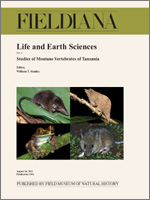Whereas the terrestrial mammal fauna of the East and West Usambara Mountains have been the subject of numerous investigations, the local bat fauna remains poorly documented, as is the case for bats of the South Pare Mountains. During mammal surveys of these three massifs, we used mist nets to collect local bats, documenting 20 bat species in total.
In the Usambara Mountains, 161 individual bats representing 19 species were documented during the three years of the survey between 1991 and 1993. In the East and West Usambara Mountains, 17 and 12 species, respectively, were recorded. Most animals were taken in net sets placed outside or at the edge of forested habitats. In the South Pare Mountains, 67 bats representing six species were collected during the two surveys, including 62 bats of six species at 1100 m (surveyed 17–29 July 1993) and five bats representing three species at 2000 m (surveyed 19–28 August 2004). Based on our morphological studies, no evidence of undescribed taxa in these collections exists.
Species common across all three massifs include two pteropodids (Epomophorus wahlbergi and Lissonycteris angolensis), one rhinolophid (Rhinolophus clivosus), and one vespertilionid (Neoromicia capensis). Taxa only captured on a single massif include Rousettus lanosus and Rhinolophus simulator (South Pare, 10% of total captures), Myonycteris relicta and Nycteris thebaica (West Usambara, 10% of total captures), and Rousettus aegyptiacus, Rhinolophus deckenii, R. fumigatus, R. swinnyi, Nycteris grandis, Myotis bocagei, and Scotophilus viridis (East Usambara, 35% of total captures).
Comparisons of capture rates and species richness between these three montane sites to more lowland forest sites indicate a notable reduction in species richness and density with increasing elevation. Our preliminary surveys are at best rough estimates of patterns of species diversity and richness in the montane portions of these massifs; more fieldwork and associated taxonomic work are clearly needed to have more in-depth knowledge of the local bat fauna.





